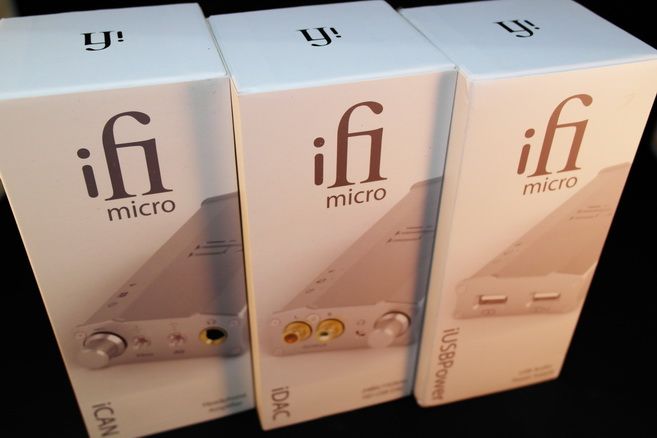
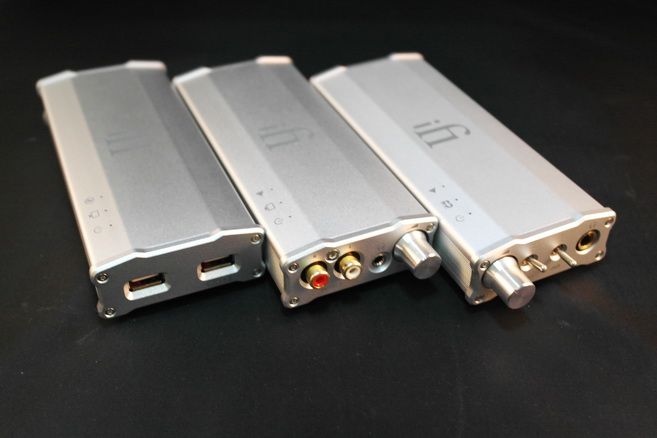
Front (from left): iUSB Power, iDAC, and iCAN.
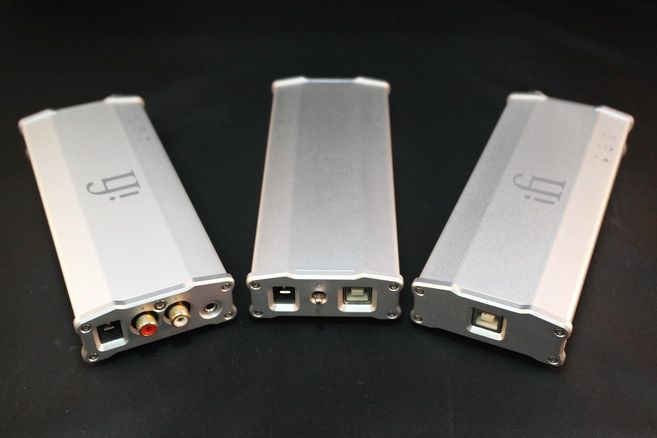
Back (from left): iCAN, iDAC, and iUSB Power.
Spec
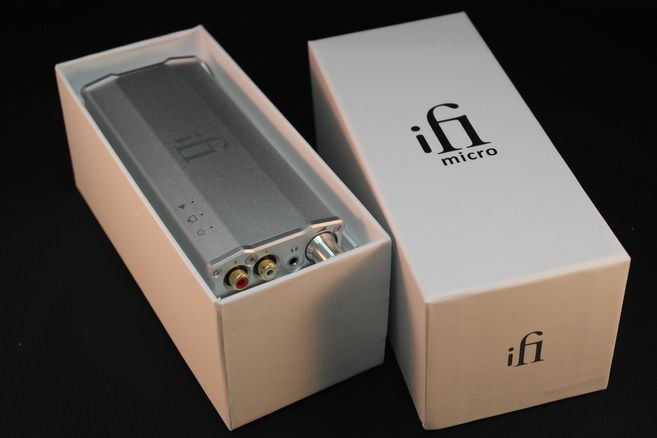
iDAC
DAC section:
ESS Sabre ES9023 DAC chip, fully supports up to 24bit, 192kbps resolution
XMOS based USB Audio Class 2 Asynchronous solution
Signal to Noise Ratio: over 111dB(A)
Dynamic Range(-60dBFs): over 111dB(A)
Crosstalk: Less than -102dB
Total Harmonic Distortion(THD): Less than 0.005%
Jitter: Below measurement limit
Frequency Response: 3Hz to 33KHz + 0.1dB/0.3dB
Output: Line-out, RCA jacks
Headphone amp section:
Opamp: MAX9722
Output Power: over 150mW (15Ω)
Output Voltage: over 3.3V (over100Ω)
Signal to Noise Ratio: over 97dB(A) (400mV/300R)
Total Harmonic Distortion: Less than 0.003% (400mV/300R)
Output Impedance (Zout): Less than 1Ω
Power Consumption: Less than 2.5W
Dimensions: 158(l)x68(w)x28(h)mm
Weight: 193g(0.43lbs)
Output: 3.5mm Stereo Jack
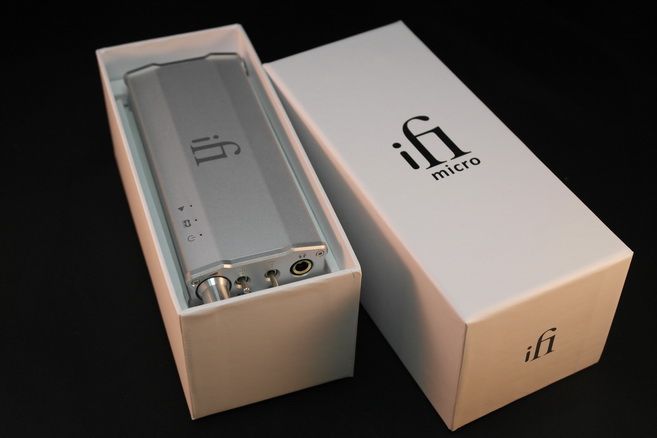
iCAN
Gain stage: Fully discrete, Class A
Buffer stage: TPA6120A2
EQ: two levels selectable 3D Holographic Sound and XBass
Signal to Noise Ratio: over 117dB(A)
Total Harmonic Distortion (THD): Less than 0.003%
Frequency Response: 0.5Hz to 500KHz(-3dB)
Output Power: over 400mW(32Ω)
Output Voltage: over 5V (over 600Ω)
Input Voltage: AC 100 - 240V, 50/60Hz
Power Consumption: Less than 4W idle, 10W max.
Dimensions: 158(l)x68(w)x28(h)mm
Weight: 216g(0.48lbs)
Input: RCA and 3.5mm stereo jacks
Output: 6.4mm stereo jacks.
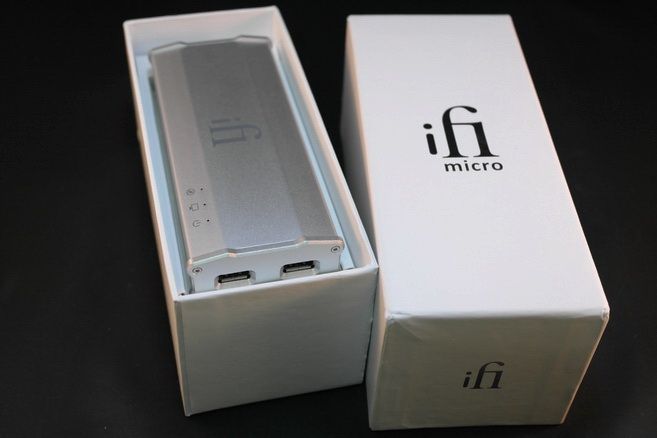
iUSB Power
Two USB sockets: one data and power and one power only (*for use with iFi Gemini cable)
Output Voltage: 5V±0.5%
Output Current: 1A
Output Noise: 0.1uV(0.0000001V)
High-Speed USB 2.0: 480Mbps
Input Voltage: AC 100 - 240V, 50/60Hz (Ultra Low-Noise Power Supply included)
Power Consumption: Less than 9W (includes powered USB device)
Dimensions: 158(l)x68(w)x28(h)mm
Weight: 195(0.43lbs)
Accessories and Build Quality
iDAC comes with simple user guide, some stick-on rubber feet, RCA cable and 2 feet of really good quality USB cable (A-to-B). iCAN comes with user guide, rubber feet, 6.4mm-to-3.5mm adapter, RCA cable, 3.5mm interconnecting cable, as well as a 9V power adapter. iUSB Power comes with the same 9V power adapter, rubber feet, user guide, USB cable as well as an USB-to-barrel plug cable. Oddly there is no mentioning anywhere about the function of the USB-to-barrel plug cable - but given the barrel plug has the same diameter as the 9V power adapter (which comes with both iCAN and iUSB Power) and it certainly can’t plug into itself, the reasonable assumption is that the cable is meant to plugged into the power only USB port at one end and iCAN on the other, serving as iCAN power supply – I tested it and it works just as assumed (* it might work with iPhono as well but I have no mean of testing it). Anyway, there seems to be no degradation of SQ by using iUSB Power as iCAN power supply based on brief listening. It is actually a very neat feature, especially when you are using iUSB Power to connect to iDAC then iDAC to iCAN. It helps to eliminate the need of an extra power adapter – however, it does come with a cost and we will discuss it on the next section. Another fun fact is that I can use this cable with a portable USB power bank to power up the iCAN and function almost like a portable amp – ‘almost’ because the sheer size and weight of iCAN + external battery are too much for portable use.
[UPDATE] from iFi Audio: the USB-to-barrel plug is intended for Squeeze Box Touch.
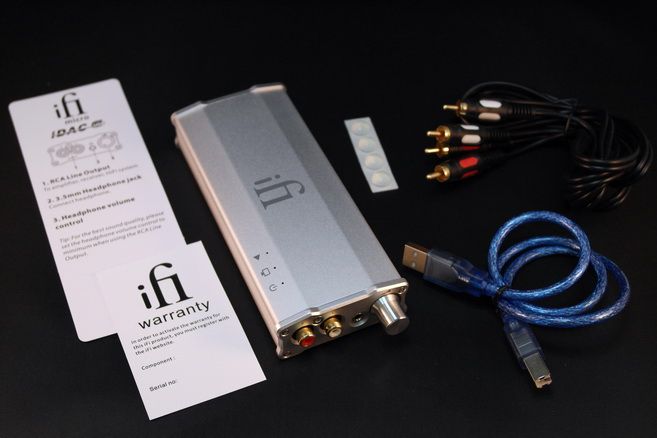
iDAC
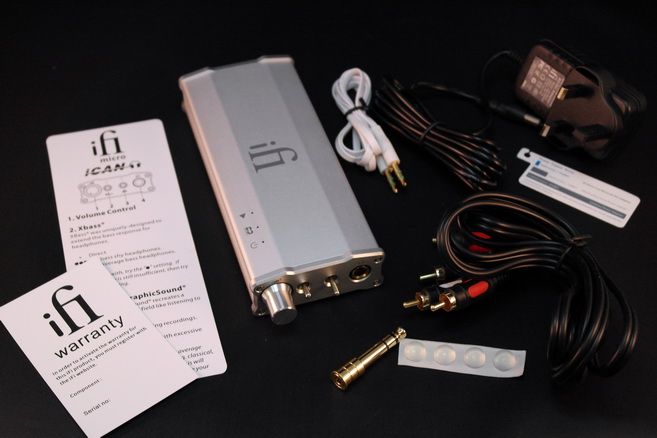
iCAN
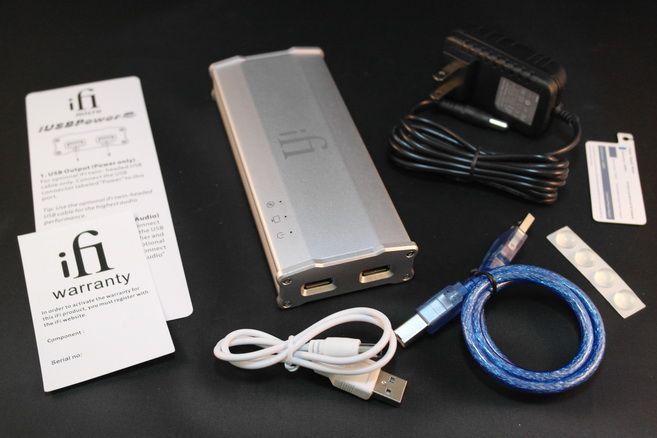
iUSB Power
Build quality is top notch. The whole Micro line use the same high quality, almost tank like aluminium housing, which is a bit too long if I am nitpicking. The real issue is that the long and narrow housing kind of limits where all the sockets can be placed. I can’t say these are the most sensible of design, but they are not terrible enough to stop me from using them. It is just that I have an urge to want to stack them up but the looping of the cable from front to back - well, isn’t exactly aesthetically pleasing. Beyond that however, I can say that all three units are excellent in quality. The (top and bottom) marking on the housing really gives them a premium look and they are not cheap, easy-to-scratch paint job.
Gain and Hiss
Gain on both iDAC and iCAN are on the high side. No official number that I know of, but my basic measurement shows that iDAC has a gain of around +15dB, with a max output of around 4.7Vrms. The line-out is a fairly standard 1.95Vrms. For iCAN, gain is about +17dB with max output of around 6.67Vrms (*iDAC as source).
With such high gain, volume tends to get too loud too fast when a low impedance, high sensitivity IEM (or similar full size) is used. With Shure SE530, I can barely go pass 8 o’clock on the iDAC’s volume knob. But on such a low position, the problem of imbalance inherent in all potentiometer becomes quite apparent. At the end, I have to lower the software volume on the PC to get them to play nice together. iCAN also doesn’t fare much better as well. It would have been great if there is a gain switch on both devices. On the upside, both have plenty of power to drive high impedance headphone without a problem. This is especially true for iCAN. [UPDATE] Newer iCAN now comes with gain switch, see last section for detail.
Hiss prone IEM (i.e. Shure SE530 again) can pick up minor hissing when the volume knob is turned close to 12 o’clock. However, this shouldn’t be too big of a deal since it is almost impossible for sensitive headphone to get this loud in actual use due to the high gain. In any case, IEM user must take note if your main IEM is low impedance, high sensitivity and hiss prone – while both iDAC and iCAN will still work, they might not be the best option in practice.
On previous section, we talk about using iUSB Power for both iDAC and iCAN at the same time to eliminate the need of an extra power adapter, but it comes with a cost – that cost is hiss, and in quite a noticeable level too. This is likely because any benefit of isolating the USB ground from the iUSB Power is lost. So at the end, it is still better to stick to the stock power adapter.

On the topic of stock power adapter - iFi Audio seems to be especially proud of it. They call it the ‘ULN’, or Ultra Low-Noise adapter. It is based on switch mode circuit, which is traditionally considered to be much noisier* than linear circuit (*due to the ripple created by the fast switching nature of the switching circuit), but have the advantage of being inexpensive and more versatile in application. In the case of ULN adapter however, iFi Audio has taken the time to craft out an adapter of exceptionally low noise (and they have shown measurement done on various adapters with tech paper). Based on my poking around of the inner on all three models, I also notice they have put a lot of know-how into noise filtration and elimination on the power line – not just on iUSB Power, but also on iDAC and iCAN. All and all, I am pretty impressed by their attention to detail on the power section.
Sound Quality
RMAA measurement on both iDAC and iCAN show no issue. In fact, iCAN performance has excessed the resolution of my measuring setup so it looks pretty much perfect. While the headphone-out on iDAC doesn’t measure as well, it is still considered excellent by my standard (low noise, flat FR curve, etc). Output impedance on iDAC is too low for my measurement, which is of course a very good thing. On the iCAN, it is about 1ohm (*more on this later). Both have excellent current output into my usual 47ohm and 23.5ohm fixed load test so that’s not a problem as well.

iDAC underbelly.
Let talk about iDAC first. The internal DAC chip is the ESS Sabre ES9023, which is the most common DAC among the ESS line-up. We have seen it on really budget USB DAC like the HiFimeDIY’s Sabre USB DAC and Stoner Audio UD100, to the more modestly priced ODAC and some really expensive DAC. On the DAC section alone, some of the more standout features of iDAC include the full 24bit, 192kbps resolution and USB asynchronous mode. These are done by employing a XMOS microcontroller with 3 reference clocks (one for USB and two for sampling rates). The USB power line also seems to be internally regulated so a little bit of ‘dirty’ USB power shouldn’t be an issue. While these are all good on paper, I have to say that these features are not something obvious to the listening. To be honest, how many can tell a good jitter from a great jitter, or a somewhat dirty USB power line from a clean USB power line? I am not sure I can. If we were to talk about just the actual sound of the line-out, it does closely resemble that of ODAC or UD100. It is not a case where you will say ‘wow, this ES9023 sounds better than the rest’. No, they all sound darn good – clean, transparent, well resolved, and those are things you can expect from any well implemented ES9023.
The real interesting bit about iDAC is in its headphone amp section. It uses a MAX9722, which is hardly a top range opamp. But the key is in its implementation, as it sounds good enough to give me the impression of iDAC being ‘ODAC + O2 roll into one device'. Okay, frankly speaking the headphone amp section still isn’t quite beat the O2 in overall performance, but it is really close. It carries the same flavour of top quality transparency in its sound. The only two noticeable areas that are not quite on par are: First, the overall image on the iDAC headphone amp not being quite as large and grand as O2. Second, the bass hit is a tad softer. Try to scale the O2 down 10%~15%, and that’s what you will hear on iDAC. Still, it is admirable and could even compete head-to-head with some standalone sub$150 amp on its own. I’ll call that a win for any headphone amp section built into an USB DAC. If I were a minimalist, I would have been very happy with just the iDAC alone.
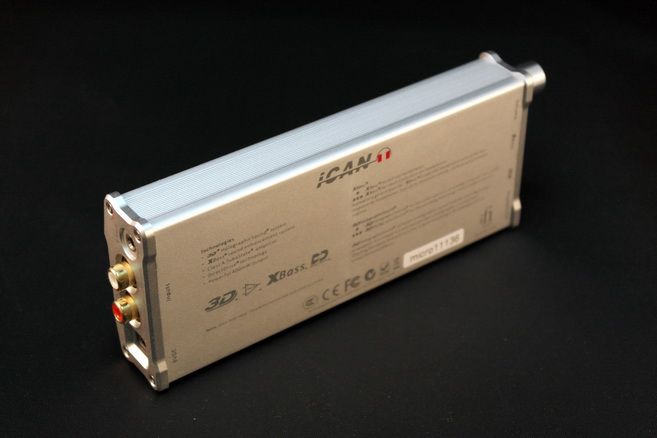
iCAN underbelly
iCAN is also an very interesting piece of gear of its own right. By looking on the inner, the ‘Class A TubeState’ section is, as far as I can tell, a fully discrete gain stage, then it employs TPA6120A2 as the buffer stage. If anything, TPA6120 has a good reputation on its sound quality and raw power, but almost always being dissed for its high output impedance. The minimum 10ohm output resistors needed for stability put TPA6120 into obvious disadvantages when it comes to low impedance headphone (*lack of electrical dampening) and even worst, low impedance multi-driver headphone with passive crossover (*coloration). But iFi is clever enough to use inductor bypassed by a small value resistor to achieve the same stability without any of the downside.
So how does it sound? In sum, identical to O2 – and that’s the highest possible complement I can give to any headphone amp(*for those who don’t know the O2 – it is a headphone amp designed with measurement to deliver the best possible transparency and performance to any sub 300ohm headphone). It is hard-pressed to find any difference in their sound when volume matched. The same authority, control, power, resolution and soundstage are shared between the two. There is no sound signature to speak of, as both are totally transparent and neutral in flavor. With the 30+ amps I have owned, just a small handful of them are able to partially match O2 in overall sound quality, and only iCAN can deliver near identical performance. They are, in my opinion, true ‘reference level’ headphone amp for others to measure up to. But the story doesn’t end there – beside top-notch sound quality, iCAN has two very functional EQ as well: the 3D Holographic Sound and XBass. We will discuss more on them in the EQ section.
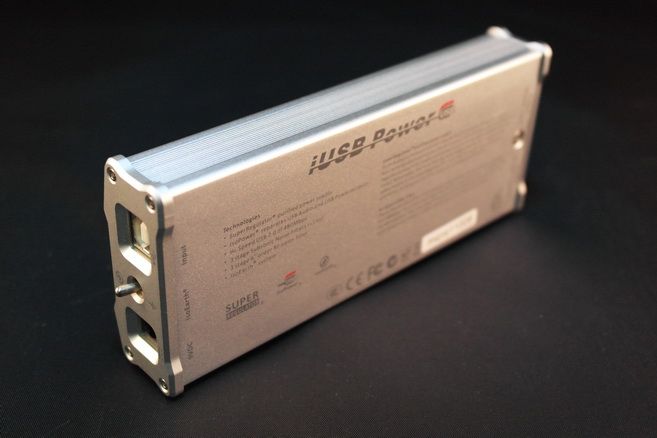
iUSB Power underbelly.
Confession: it is never my intention to get the iUSB Power to use with iDAC (or iCAN) in the first place. I needed a good USB isolator for other application and iUSB Power fits the bill. So there is no expectation that it will improve the SQ of iDAC. In fact, my PC has really clean USB power so I never run into trouble with any of my USB DAC before. But since I have it, might as well use it for its original intended purpose. RMAA measurement is carried out on both iDAC’s line-out as well as on UD100, with and without the iUSB Power, plus with and without isoEarth (ground noise elimination system) engaged. Result? Well, nothing is really different between the measurements. Audibly, I also can’t detect any difference on both UD100 and iDAC line-out as well. My conclusion is, since I know I have really clean USB port in the first place, any benefit from the iUSB Power should be minimum at best. But the story didn’t end there – does iUSB Power brings any improvement to the setup? Yes, it is to the iDAC’s headphone-out. As I have said previously, iDAC headphone amp section is like a scaled down O2. With the iUSB Power however, the soft hitting bass get turn up a notch and the overall soundstage opens up, especially in the depth. It seems to take on a slightly different personality than just a ‘baby O2’. It kind of reminds me of JDS Labs’ C421-AD8620 more than O2, but it is certainly closer to the performance level of O2 than before. My guess is, since PC’s USB port is limited to 500mA while the iUSB Power can supply up to 1A, the improvement of the headphone amp section is a sign of the extra juice. The reason why neither UD100 (which only outputs line-out) nor iDAC line-out show any difference is because neither of them is designed to output current, so the extra current supply make no difference. Well, that the best theory I have anyway.
The big question is, does it worth getting the iUSB Power? As I have said before, I would have been very happy with just the iDAC alone. The improvement from iUSB Power is noticeable, but not quite the doubling of total price. If you are looking for the best bang for the buck, I would think iDAC alone is more than suffice. iUSB Power is the option for those who really want the best of the best at any cost. Also, as I have mentioned, iUSB Power will likely to be more beneficial to those USB DAC that has a headphone amp or meant to drive headphone directly. So if you are only using iDAC as line-out (or USB DAC like UD100, which is limited to line-out only), you might not get a clear cut result.
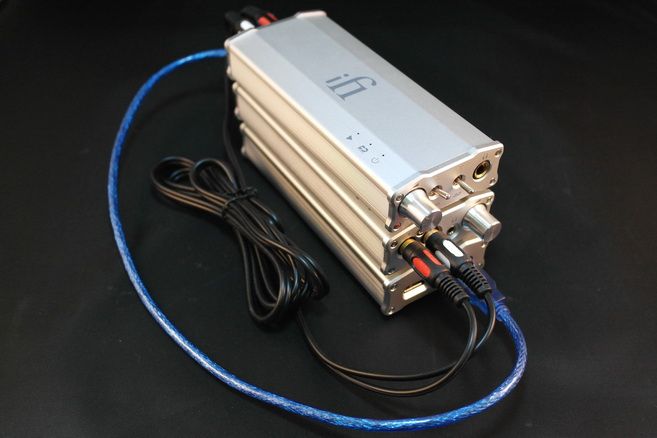
Triple Stack (from top): iCAN, iDAC, and iUSB Power.
EQ
iCAN comes with two EQ: 3D Holographic Sound (3DHS) and XBass. Both have two levels of adjustments.
The first level of 3DHS is pretty much the same as most crossfeed implementations I have heard before (HeadRoom BitHead, Meier Audio Corda 3MOVE, FiiO E12, etc), neither better nor worst. I generally don’t find crossfeed of this type to be particularly useful or enjoyable, so I usually don’t use it. The 2nd level of 3DHS on the other hand is a completely different beast. It sounds much closer to a full 3D simulation, like a cross between SRS and BBE in a very good way. It gives a very ‘surround sound’ effect without overdoing anything or making it sounds fake. It is good enough that I first thought that it must have some kind of DSP processing involved, but it is actually all analog based, which is actually quite impressive.
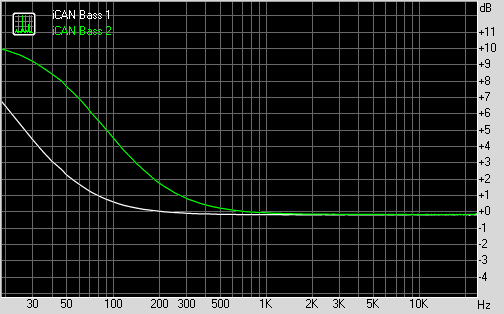
XBass: light and heavy booth.
The two levels of XBass are closer to a sub-bass boost. First level starts just under 200Hz and peaks around +7dB @ 20Hz. The 2nd level starts just under 800Hz and peaks around +9dB @ 20Hz. Both are strong at boosting sub-bass but have minimum effect over the rest of the frequency range. Overall, they perform very well.
Both 3DHS and XBass can be engaged at the same time with different combo. They are quite fun to play with and can be very useful to some headphone. They are really icing of the cake to the already great sounding iCAN.

Size comparison: iCAN, iDAC and iUSB Power with O2 (left), FiiO E12 (right) and FireStone Auido Fireye HD (lower right).
…in Summery
All and all, I am quite impressed by all three iFi ‘Micro’ gears. They perform well and priced reasonably. You can probably get an ODAC + O2 combo that is a little cheaper and offer similar sound quality, but you won’t get as much features as either iDAC or iCAN. The only thing I wish to have is a gain switch on iDAC and iCAN most because I am mainly an IEM user. Too much gain makes for much lesser control over volume. Beyond that, I have no problem recommending them. iDAC is a great option as an all-in-one solution while iCAN is an fantastic headphone amp. As for iUSB Power, it is not a ‘must have’ unless you are pushing for the last few percent of the performance, but it does its job as claimed. For a relatively fresh brand, iFi has made a good name for itself with these Micro gears and proven that it has the same audiophile blood in its veil as its higher-end sibling.
A thank to iFi Audio for the iDAC and iCAN review unit.





